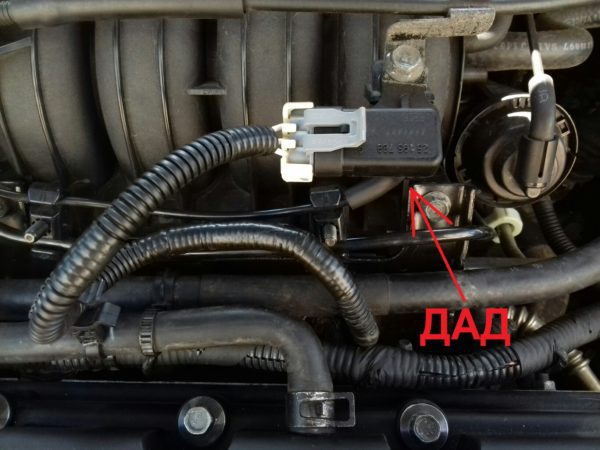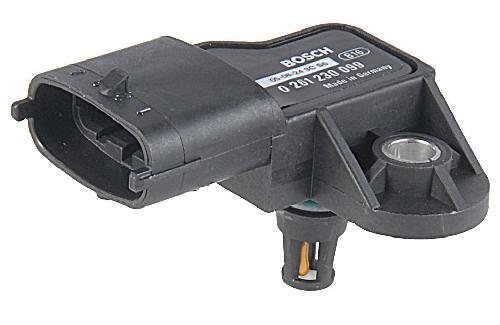
P0106 - MAP / Atmospheric Pressure Loop Range / Performance Problem
Content
OBD-II Trouble Code - P0106 - Data Sheet
Manifold Absolute Pressure / Barometric Pressure Circuit Range / Performance Issues
DTC P0106 appears when the engine control unit (ECU, ECM, or PCM) registers deviations in the values recorded by the manifold absolute pressure (MAP) sensor.
What does trouble code P0106 mean?
This Diagnostic Trouble Code (DTC) is a generic transmission code, which means it applies to OBD-II equipped vehicles. Although general, specific repair steps may differ depending on the brand / model.
The powertrain control module (PCM) uses a manifold absolute pressure (MAP) sensor to monitor engine load. (NOTE: Some vehicles have an Atmospheric Pressure (BARO) sensor that is an integral part of the Mass Air Flow (MAF) sensor but does not have a MAP sensor. Other vehicles have a MAF / BARO sensor and a backup MAP sensor where the MAP sensor works. as a backup input in case of a mass air flow failure.
The PCM supplies a 5V reference signal to the MAP sensor. Typically, the PCM also provides a ground circuit for the MAP sensor. When the manifold pressure changes with load, the MAP sensor input reports to the PCM. At idle, the voltage should be between 1 and 1.5 V and approximately 4.5 V at wide open throttle (WOT). The PCM ensures that any change in manifold pressure is preceded by a change in engine load in the form of changes in throttle angle, engine speed, or exhaust gas recirculation (EGR) flow. If the PCM does not see a change in any of these factors when it detects a rapid change in the MAP value, it will set P0106.
 Typical MAP sensor
Typical MAP sensor
Possible symptoms
The following could be a symptom of P0106:
- Engine runs rough
- Black smoke on the exhaust pipe
- Engine does not idle
- Poor fuel economy
- Engine misses at speed
- Engine malfunction, the characteristics of which are not optimal.
- Difficulty of acceleration.
Causes of the P0106 code
The MAP sensors perform the task of recording the pressure in the intake manifolds, which are used to calculate the mass of air drawn into the engine without load. In automotive parlance, this device is also known as a boost pressure sensor. It is usually located before or after the throttle valve. The MAP sensor is internally equipped with a diaphragm that flexes under pressure; strain gauges are connected to this diaphragm, which register changes in the length of the diaphragm, which, in turn, corresponds to the exact value of electrical resistance. These changes in resistance are communicated to the engine control unit, which automatically generates a P0106 DTC when the values recorded are out of range.
The most common reasons to track down this code are as follows:
- Suction hose defective, e.g. loose.
- Wiring failure, as, for example, wires may be too close to higher voltage components such as ignition wires, affecting their operation.
- Malfunction of the MAP sensor and its components.
- Operational mismatch with throttle sensor.
- Engine failure due to a defective component, such as a burnt valve.
- A malfunctioning engine control unit sends incorrect signals.
- Malfunction of the absolute pressure manifold, as it is open or shorted.
- Intake manifold absolute pressure sensor circuit malfunction.
- Water / dirt ingress on the MAP sensor connector
- Intermittent open in the reference, ground or signal wire of the MAP sensor
- Intermittent short circuit in MAP sensor reference, ground, or signal wire
- Ground problem due to corrosion causing intermittent signal
- Open flexible duct between MAF and intake manifold
- Bad PCM (don't think PCM is bad until you've exhausted all other possibilities)
Possible solutions
Using a scan tool, observe the MAP sensor reading with the key on and the engine off. Compare the BARO reading with the MAP reading. They should be approximately equal. The MAP sensor voltage should be approx. 4.5 volts. Now start the engine and notice a significant drop in the MAP sensor voltage, indicating that the MAP sensor is working.
If the MAP reading does not change, do the following:
- With the key on and the engine off, disconnect the vacuum hose from the MAP sensor. Use a vacuum pump to apply 20 inches of vacuum to the MAP sensor. Is the voltage dropping? Must. If he does not check the vacuum port of the MAP sensor and the vacuum hose to the manifold for any restrictions. Repair or replace as necessary.
- If there is no limit and the value does not change with vacuum, do the following: With the key on and the engine off and the MAP sensor off, check for 5 Volts on the reference wire to the MAP sensor connector using a DVM. If not, check the reference voltage at the PCM connector. If a reference voltage is present at the PCM connector but not at the MAP connector, check for an open or short circuit in the reference wire between MAP and PCM and recheck.
- If a reference voltage is present, check for a ground at the MAP sensor connector. If not, repair the open / short circuit in the ground circuit.
- If earth is present, replace the MAP sensor.
Other MAP sensor trouble codes include P0105, P0107, P0108, and P0109.
Repair Tips
After the vehicle is taken to the workshop, the mechanic will usually perform the following steps to properly diagnose the problem:
- Scan for error codes with an appropriate OBC-II scanner. Once this is done and after the codes have been reset, we will continue to test drive on the road to see if the codes reappear.
- Inspect vacuum lines and suction pipes for any anomalies that can be corrected.
- Checking the output voltage at the MAP sensor to make sure it is in the correct range.
- Checking the MAP sensor.
- Inspection of electrical wiring.
- Generally, the repair that most often cleans up this code is as follows:
- MAP sensor replacement.
- Replacement or repair of faulty electrical wiring elements.
- Replacement or repair of the ECT sensor.
It should also be borne in mind that cars with a mileage of more than 100 km may have problems with sensors, especially at the starting stages and in stressful situations. This is often due to wear and tear associated with time and the high number of kilometers traveled by the vehicle.
Driving a vehicle with a P0106 DTC is not recommended as the vehicle may have serious handling problems on the road. Added to this is also the higher fuel consumption that will have to be faced in the long term.
Due to the complexity of the interventions required, a do-it-yourself option in a home garage is not feasible.
It is difficult to estimate the upcoming costs, since a lot depends on the results of the diagnostics carried out by the mechanic. As a rule, the cost of replacing a MAP sensor is around 60 euros.
Frequently Asked Questions (FAQ)
What does code P0106 mean?
DTC P0106 indicates an abnormal value recorded by the manifold absolute pressure (MAP) sensor.
What causes the P0106 code?
The causes for this code are many and range from a faulty suction pipe to defective wiring, etc.
How to fix code P0106?
It is necessary to conduct a thorough check of all elements associated with the MAP sensor.
Can code P0106 go away on its own?
In some cases, this DTC may disappear on its own. However, checking the sensor is always recommended.
Can I drive with code P0106?
Driving with this code is not recommended, as the car may have serious problems with directional stability, as well as have increased fuel consumption.
How much does it cost to fix code P0106?
As a rule, the cost of replacing a MAP sensor is around 60 euros.
Need more help with your p0106 code?
If you still need help with DTC P0106, post a question in the comments below this article.
NOTE. This information is provided for informational purposes only. It is not intended to be used as a repair recommendation and we are not responsible for any action you take on any vehicle. All information on this site is protected by copyright.
